Defend Against XSS Attacks with Open-Source Vulnerability Scanners

Linux Cross-Site Scripting (XSS) attacks take place when a threat actor injects malicious, executable scripts into the code of a trusted application or website. XSS is a prevalent and serious data and network security threat for developers and their projects. It is estimated that more than 60% of web applications are susceptible to XSS attacks, which eventually account for more than 30% of all web application exploits in cybersecurity.
If the proper security measures have not been taken to secure applications and websites against these attacks, Linux Cross-Site Scripting can enable a hacker to steal the user’s active session cookies. The higher the compromised user's privileges are in an application, the more critical the impact of the attack is likely to be, and if users input sensitive, personally identifiable information, the repercussions of an attack can be even more severe.
Luckily there are many great Linux Cross-Site Scripting open source vulnerability scanners available to Linux users. Such cloud security scanners enable developers to find and fix XSS cybersecurity vulnerabilities before they are exploited by attackers. This article will introduce six great open source Linux Cross-Site Scripting vulnerability scanners you should know about that will help you protect your websites and applications against any data and network security threats.
What Is A Cross-Site Scripting Attack? How Does It Work?
As previously mentioned, Linux Cross-Site Scripting attacks are when a threat actor injects malicious executable scripts into the code of a trusted application or website. Attackers often initiate a Linux Cross-Site Scripting attack by tricking a user into clicking through a malicious link. If the app or website lacks proper data sanitization, the malicious link executes the attacker’s chosen code on the user’s system. The following criteria must be met in order for a Linux Cross-Site Scripting attack to occur:
- Data enters a web application through an untrusted source, most frequently a web request.
- The data is included in dynamic content that is sent to a web user without being validated for malicious content.
The variety of cloud security breaches that can be carried out based on Linux Cross-Site Scripting is almost limitless, but these attacks in network security commonly include transmitting private data to the attacker, redirecting the victim to web content controlled by the attacker, or performing other malicious operations on the user’s machine under the guise of the vulnerable site.
Cross-Site Scripting Vulnerability Categories to Know
There are multiple types or categories of Linux Cross-Site Scripting (XSS) attacks and vulnerabilities you should keep in mind. Here is a list:
- Reflected XSS (Non-Persistent or Type I) occurs when user inputs immediately get returned by a web application in an error message, search result, or other response that includes some or all of the input provided by the user as part of the request without that data being made safe to render in the browser and without permanently storing the user provided data.
- Stored XSS (Persistent or Type II) Stored XSS generally occurs when user input is stored on the target server, like a database, message forum, visitor log, or comment field. Then, a victim retrieves the stored data from the web application without that data being made safe to render in the browser.
- DOM-based XSS (Type-0) is a form of XSS where the entire tainted data flow from source to sink takes place in the browser. The source of the data is in the DOM, the sink is also in the DOM, and the data flow never leaves the browser.
- Server XSS occurs when untrusted user-supplied data is included in an HTTP response generated by the server.
- Client XSS occurs when untrusted user-supplied data is used to update the DOM with an unsafe JavaScript call.
Tips to Protect Against XSS Attacks
Here are some of the best practices to utilize against Linux Cross-Site Scripting attacks in network security:
- Never trust user input.
- Implement output encoding.
- Perform user input validation.
- Use a Web Application Firewall (WAF).
- Use one of the XSS open-source vulnerability scanners we recommend below.
- Implement an in-depth defense strategy for securing websites and applications.
- Ensure that web application development aligns with OWASP’s XSS Prevention Cheat Sheet.
- After remediation, perform penetration testing to confirm it was successful.
Top Open Source Vulnerability Scanners for Cross-Site Scripting
Open source Cross-Site Scripting (XSS) vulnerability scanners are a helpful part of network security toolkits designed to help identify and prevent Linux Cross-Site Scripting exploits in cybersecurity by automating the process of searching for potential web application security vulnerabilities. Here are some of the top open-source vulnerability scanners for Linux Cross-Site Scripting:
Damn Small XSS Scanner
Damn Small XSS Scanner (DSXS) is a free and open-source Cross-Site Scripting (XSS) vulnerability scanner. Some of DSXS’ key features include:
- Simplicity: DSXS is designed to be a simple and easy-to-use tool for identifying XSS web application security vulnerabilities, making it accessible to a wide range of users, including those with limited technical expertise.
- Automated scanning: DSXS automates the searching process, reducing the time and effort required to identify potential network security issues.
- Payload generation: DSXS provides a range of payloads to test for XSS cybersecurity vulnerabilities, allowing administrators to test for a wide range of possible network security threats.
- Reporting: DSXS provides basic reporting of the results of its scans, including information on found vulnerabilities, the payload used, and the affected URL.
DSXS is unique in its simplicity. Its straightforward and easy-to-use interface makes it a good choice for users who may be new to XSS scanning and web application security. This network security toolkit is great for learning purposes because of its small, understandable code base. Below you will see how Damn Small XSS is utilized in an actual Cross-Site Scripting attack scan:
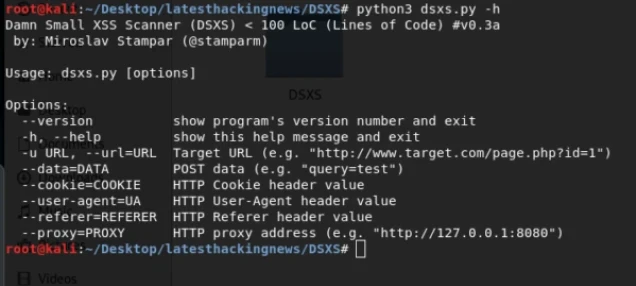
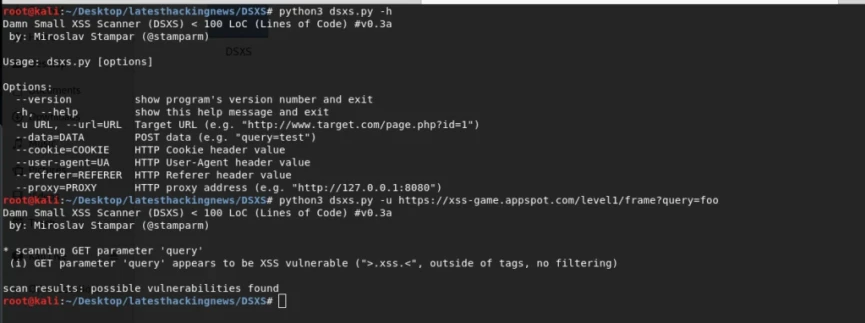
Pwnxss
Pwnxss is a free and open-source vulnerability scanner for Cross-Site Scripting. Here are its key features:
- Automated scanning: PwnXSS automates the process of finding potential XSS web application security vulnerabilities so that companies can use their time and effort elsewhere.

- Real-time detection: PwnXSS provides real-time detection of XSS network security issues, allowing administrators to take immediate action to prevent exploits in cybersecurity.
- Payload generation: PwnXSS offers administrators the chance to run tests for various network security threats that could result in XSS attacks so businesses can utilize security patching to take care of risks quickly.
- Reporting: PwnXSS provides detailed reporting of the results of its scans, including information on the type of vulnerability found, the payload used, and the affected URL.
PwnXSS offers real-time detection of XSS vulnerabilities and provides instant feedback on potential security risks, which allows administrators to take immediate action to mitigate attacks in network security.
Here are the programming steps or inputs you need in order to install PwnXSS:
- pip install bs4
- pip install requests
- git clone https://github.com/pwn0sec/PwnXSS
- chmod 755 -R PwnXSS
- cd PwnXSS
- python3 pwnxss.py --help
- python3 pwnxss.py -u http://testphp.vulnweb.com
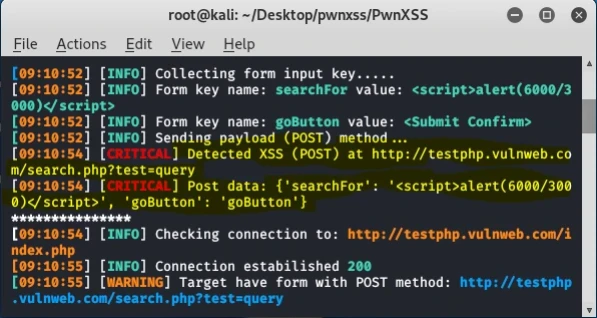
W3af
W3af is a free and open-source web application security scanner that is designed to identify cybersecurity vulnerabilities and formulate comprehensive solutions for Cross-Site Scripting attacks. Key W3af features include:
- Automated scanning: W3af identifies potential network security issues through an automated
 XSS cybersecurity vulnerabilities search process.
XSS cybersecurity vulnerabilities search process. - Multiple vulnerability detection: W3af is designed to detect a wide range of vulnerabilities, including XSS and SQL injection, making it a comprehensive network security toolkit for web applications.
- Customizable scan profiles: W3af provides customizable options so administrators can tailor the scanning process to their specific needs.
- Reporting: W3af provides detailed reporting of the results of its scans, including information on the type of vulnerability found, the payload used, and the affected URL.
W3af has a comprehensive approach to data and network security. W3af’s ability to detect a wide range of web application security vulnerabilities and its customizable scan profiles make it a flexible and effective tool for identifying and preventing XSS attacks in network security.
Below you will see how W3af is used:
Audit: plugins used to detect vulnerabilities in URLs or forms provided by discovery plugins.
 Brute Force: plugins used for brute force login forms as well as http-auth logins.
Brute Force: plugins used for brute force login forms as well as http-auth logins.
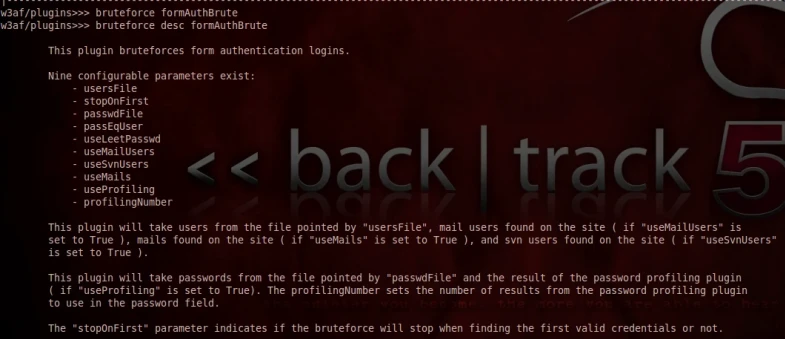
XssPy
XssPy is a free and open-source vulnerability scanner for Cross-Site Scripting designed to identify and prevent X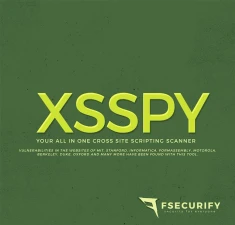 SS attacks in network security. Here are its key features:
SS attacks in network security. Here are its key features:
- Automated scanning: XssPy automates the process of searching for cybersecurity vulnerabilities involving Cross-Site Scripting, minimizing the time and effort needed for risk identification.
- Multiple injection methods: XssPy supports multiple injection methods, including GET and POST requests, allowing for a more comprehensive scan of web applications.
- Custom payloads: XssPy allows administrators to use custom payloads when searching for XSS web application security vulnerabilities, providing more flexibility and control over the scanning process.
- Reporting: XssPy provides detailed reporting of the results of its scans, including information on the type of vulnerability found, the payload used, and the affected URL.
XssPy has a focus on automation processes and supports multiple injection methods and custom payloads, providing more comprehensive and flexible scanning capabilities compared to other XSS open source vulnerability scanners.
OWASP Xenotix XSS
OWASP Xenotix (Open Web Application Security Project) helps identify and prevent XSS attacks in network security by automating the process of searching for potential web application security vulnerabilities. Key features of OWASP Xenotix include:
- Automated scanning: OWASP Xenotix reduces the time and effort workers need in order to mitigate network security issues by automating the search process for them.
- Multiple injection methods: OWASP Xenotix supports multiple injection methods, including GET and POST requests, allowing for a more comprehensive scan of web applications.
- Custom payloads: OWASP Xenotix allows administrators to use custom payloads when searching for XSS cybersecurity vulnerabilities, providing more flexibility and control over the scanning process.
- Reporting: OWASP Xenotix provides detailed reporting of the results of its scans, including information on the type of vulnerability found, the payload used, and the affected URL.
OWASP Xenotix focuses on automation and flexibility, support for multiple injection methods, and the use of custom payloads, all of which provide a comprehensive and flexible approach to XSS cybersecurity vulnerabilities in web applications. Additionally, being part of the OWASP community ensures credibility and reliability for the network security toolkit.
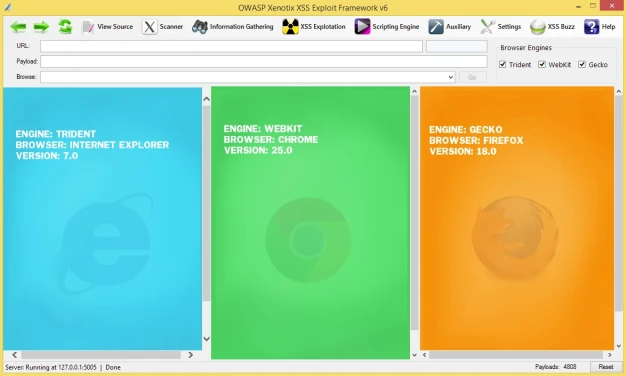
Final Thoughts on Preventing XSS Attacks with Open-Source Vulnerability Scanners
Linux cross-site scripting attacks are common and severe data and network security threats that can put developers and their projects at risk. A successful attack can compromise sensitive personal or financial information, so it is imperative to take measures to protect against Linux Cross-Site Scripting cybersecurity vulnerabilities.
By implementing the open-source vulnerability scanners and tips discussed in this article, you can secure your work and sensitive data against compromise and other attacks in network security.





















